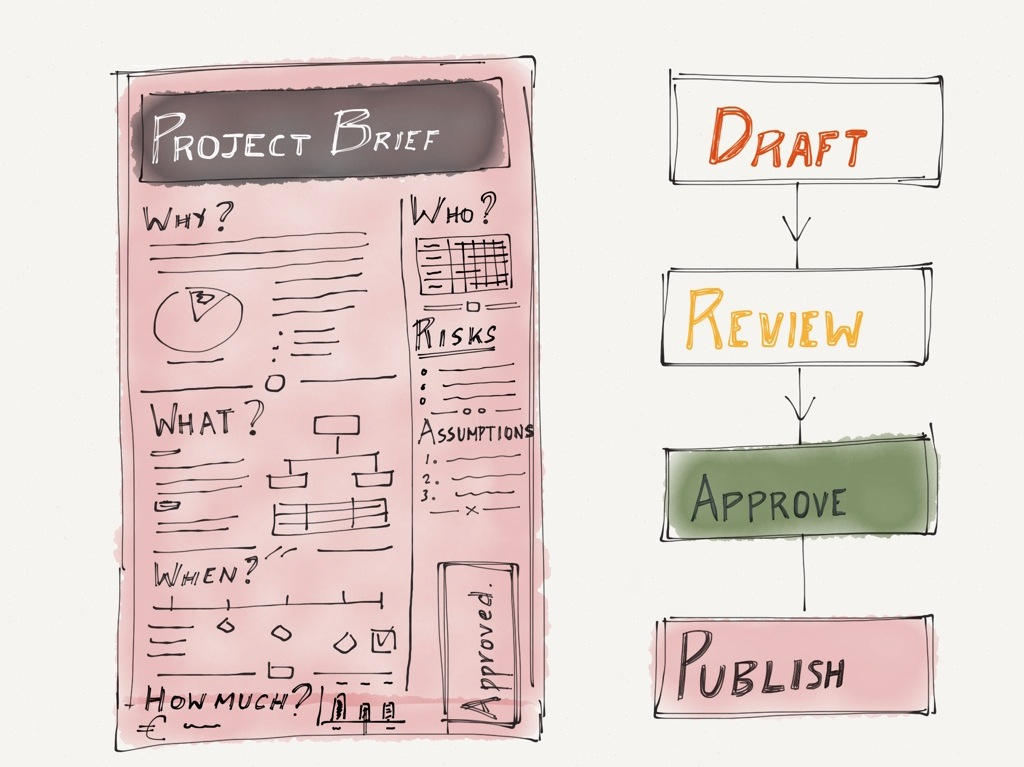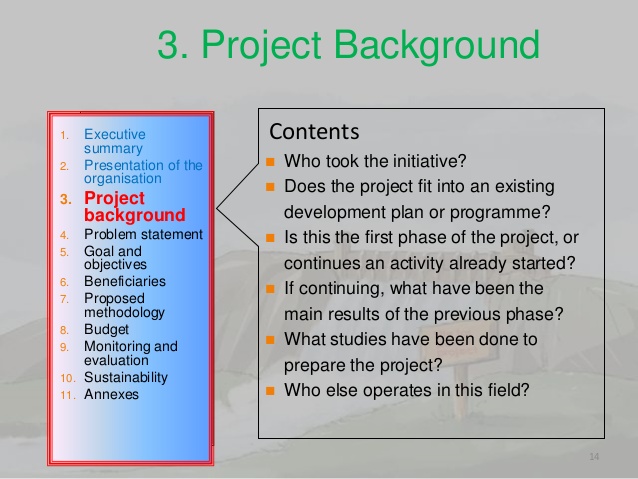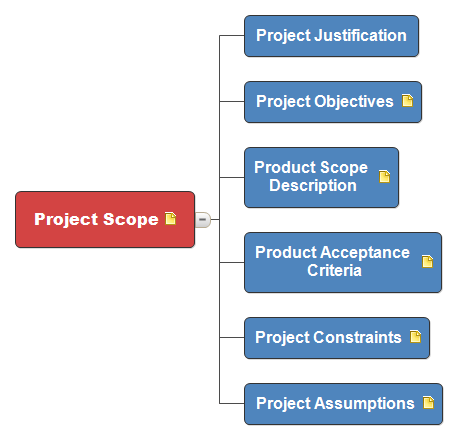How to write a good project brief
Having problems writing down project brief?
Not sure what to include in it? Worry not, we have prepared a detailed guide which will provide instructions for writing every step of the project brief.
Always remember that project brief is one of the important things that you do before you actually start working on a project.
It is a compilation of multiple things related to project such as planning, outlines, structure, timeline, payment details along with objectives and outcome as well.
You can define it as a brief yet detailed to the point description which covers all key points of the project, including the scope and vision of the project.
Think of it as a training plan which outlines your schedule. It may not cover all the details of your planning and preparation but it works as a referral guide.
You can make a project brief from an outlining structure or you can make it a detailed guide or anything in between.

Project brief are of generally two types, loose project brief and tight project brief.
When you prepare a loose project brief, you are talking more about a general set of guidelines instead of a strict operation plan.
This kind of brief is suitable for creative or design project or if you want to give more control to your team and let them decide things and discuss ideas instead of holding the reigns.
Prepare a tight project brief, if you want to give less control to the team over deciding things and rather let them focus on the implementation of a particular working plan.
This is preferred when you have a clear idea of what the project has to be, owing to client expectations, past similar projects, and more.
You can further divide a project brief into several components such as the project description, investment plan, performance monitoring options, the scope of a project, project management etc.

Here’s a list of the key components which you need to include in your project brief to make it a good project brief.
- Project Description
- Project Goals and Outcomes
- Investment Plan
- Performance management
- Project Management Plan
- Project Oversight
Before proceeding ahead, know that the project brief should be prepared by project manager only.
A good project manager ensures that the project brief presented contains all the detailed facts and figures along with all the necessary information required.
Read our guide on how to be a good project manager.
Project Description
Here, you have to cover the background of the project, timeline in which it has to be completed, the scope of the project, budget assigned to it and other things such as guidelines and constraints as well.
- Project Background
- Project Output
- Project Scope
- Project Cost
- Project Schedule
- Guidelines and Constraints

Image Source
Project Background
Here, you have to cover a brief description of the project’s history, prerequisites of the project and how the project will be carried out.
You need to cover the focus of the project and the desired outcome and explain them. Project background is an integral part of the project description, but don’t confuse it with the entire project description and keep it specific and brief.

Keep these pointers in mind while drafting the statement for project background :
1. A project background is just a simple short statement of the project consisting of the project need, address of problems and requirements giving a general overview of the project and explaining the key pointers.
2. Project description, on the contrary, is a detailed explanation of the goals and objectives of the project, potential challenges, and downsides, allocation of resources, methods of implementation and more.
3. While the purpose of the project description is to create a foundation for further development of the project, project background serves the sole purpose of giving an initial impression to the potential investors and/or sponsors.
Project Output
In this part of the project brief, provide a brief description of the service or capability that you intend to develop, create or modify via this project.
Also, include the benefits associated with it and their management after project completion.
Project Scope
Project scope is the part of project brief which includes determining a list of project goals, functions, tasks, deadlines and documenting them.
You also have to cover the work which needs to be done to achieve that. While defining the scope of the project, you have to analyze the maturity of the project and its complexity.
Project maturity here refers to the progressive development of project management approach, strategy, and decision-making process.
Based on the specific project goals, needs, resources, maturity will vary for each project.

The scope statement includes and addresses a number of key factors such as activities, outputs, and important performance criteria.
Along with that, it should also cover details about how this scope was developed, and the determination of requirements, scope definition in accordance with defined requirements.
Project Cost
Project costs section covers required budget and its usage with an estimate for further funds if needed.
Make sure to be detailed in it and cover everything from the start of the project to its completion.
You can do this by including the methods for approximating cost, source references, and the nature of costs. Also, include assumptions, exclusions, risk, and contingency.
There are mainly 4 steps to determining this:
- Planning Cost Management
- Estimating Costs
- Determining Budget
- Controlling Cost
First, you need to create a plan for the cost management in which you need to include ways to control spending and developing the project budget.
After you’re done with it, prepare a list of your needs such as goods/services needed for the completion of the project. It is done in the planning stage itself.
You can take the help of project cost management software for this.
After estimating the approximate cost of the project, you can use cost spreadsheets to develop a framework for budget and determine the budget.
The project manager does it with the help of the financial department and in cooperation with the project sponsor.
The last step is to control spending. In this, you need to track your spending and make sure that the costs are fully covered within the allocated budget.
Project Schedule
This section consists of a properly documented authoritative schedule prepared by you. Make sure that this schedule consists of milestones, key project outputs, and details on implementation planning.
The schedule that you provide here covers the events from the start of the project to its completion.
While creating this schedule, remember the set of features such as complexity of your project, changes required over time.
Guidelines and Constraints
In this section, outline any strategies that might be implemented in the project if found of use.
You have to include all the limitations and constraints imposed on the project as well. Guidelines on imposing these instructions can also be included.
Project Goals and Outcomes
You can use this section to explain the project expectations and its outcomes. Details that you provide here should cover all specifics along with their brief explanation.

Keep in consideration that purpose of a project brief is to convey the message in a simple and decisive manner.
In this section, project’s expected outcomes have to be explained and further conveyed in common man terms instead of using technical jargon.
At the same time, you have to keep it brief and to the point as well. Some of the questions whose answer should be covered in this are:
- What is the specifically targeted business outcome?
- Why is this specific outcome needed?
- Why is the project needed to go now? (and consequences of delayed action)
You can also cover the interim goals of the project, which would help in better understanding of the project and of the process leading to the final outcomes.
This section also needs to describe the mandate of the concerned department and if any supporting departments.
It should show that the projected outcome is supported by the end results of the project and how the achievement of project goals on time will support the desired project outcome.
Investment Plan
In this, you have to show that the outcome of the project does justice to the investment that’s being asked.
The investment proposal included in this section should support the claims that you made in the project description.
Also, explain the estimated life-cycle of investments along with returns expected. The investment asked here needs to include the entire cost of operation.
You can compute the entire operation cost by calculating the cost of subsequent activities and further maintenance and disposable.
All this in addition to the already estimated cost of the project.

Image Source
Project proposal needs to consist the affordability of the proposed investment as well, and the possibility of further investment in future if needed.
Also, show that how the investment remains sustainable over the required period of time and affordable.
In the end, you need to get investment plan approved by the budget department.
Performance Management
You have to provide ways and adequate measures for evaluating performance and outcome management in this section.
These measures often consist of evaluation strategy by independent third-party if and when required.
It can be further divided into three different parts each with their respective significance.
- Business Outcome Management Strategy
- Project Performance Management Strategy
- Audit and Evaluation Strategy

Business Outcome Management Strategy
Here, in this section, you have to cover in detail the strategy for measuring, monitoring, reporting and managing the business outcomes.
Based on those outcomes, the proposed model of the project is evaluated with it.
Depending on the evaluation, the realization of the outcome is further reviewed under the decision points of “go” and “no-go” over the project life cycle.
It’s also a good practice if you maintain a record of the outcomes and the measures associated with it.
Project Performance Management Strategy
Similar to above, this section includes ways to manage ongoing project performance and measure its results.
Along with that, you also need to include a detailed explanation of how project progress is monitored and tracked.
Monitoring of progress and performance tracking is done mostly in the terms of metrics associated with cost, schedule, scope and any other critical objectives.
Additionally, you should also mention the outlined strategy for the project management plan and aligns it with the project schedule.
Audit and Evaluation Strategy
The last thing that is required of you is to prepare a detailed audit and evaluation strategy.
This strategy needs to include all provisions for independent third-party evaluations, reviews or audits whenever if required.
You should also address the different phases of the life cycle of the project mentioning when monitoring and reporting activities are planned.
Project Management Plan
You need to cover a brief summary of the entire project management plan in this section.
A project management plan should cover planned objectives, outcomes of the project, giving the scope, breaking down the work structure, resources, governance, roles, risks, schedule, budget, functional strategies, project monitoring and control strategies, process deviations, and management approach.

Image Source
In this section, you also need to cover and describe the project gating strategy, including any planned independent third party evaluations, reviews or audits.
Including this strategy ensures that usage of resources and results are fully visible to the project approval authority.
This further explains the segmentation of project into gates and the phased approach to managing changes.
Furthermore, you can also cover the project change management strategy and the specific methods on which the strategy is based upon.
Some of the things which should be considered to be included in this are:
- Change in control board procedures
- Detailed tracking and reporting of progress of changes in project
- Process for logging, analyzing, and finally approving requests for project change.

Next is the risk management strategy, in which you can include the detailed information regarding the risk factors that can affect the project and a plan for identifying, analyzing and prioritizing them.
Other than that, you can also include complete plans for assessing risk factors for the ongoing identification, assessment, and mitigation of those factors throughout the life cycle of a project.
Another thing you need to cover in this is procurement strategy which is only when the requirements are to be met by procurement activities.
Procurement strategy for any project consists of the procurement contracts or contractual arrangements which are necessary in order to be able to achieve the defined project outcomes.
It explains in detail the concerned department responsible for a particular contract. It also provides the anticipated value and duration of each contract along with the likelihood of those contracts getting the requisite approval.
Procurement Strategy also depicts the approach for solicitation and evaluation of bids as well as the fashion in which the contracts will be awarded.
You need to take economic factors into major consideration while developing a suitable procurement strategy.
It should also explain as to how the proposed approach meets the objectives of fair, transparent and open procurement.
Project Oversight
In this section of the project brief, you need to cover the overview of the project including these main points :
- Accountability for future project outcomes
- Responsibilities and roles of the associated departments and different units within the main heading department
- Structure of the committee which is focused on achieving the program objective inside the project.
You should see that the content of this section is able to provide the concerned approval authority with a clear understanding of the complete project oversight.
Project oversight encompasses accountability and requires authority. You also need to cover the various roles and responsibilities of concerned authorities required for the management of the project.
There are three main persons associated with a project whose roles and responsibilities you need to cover in this section.
- Project Manager
- Business Sponsor
- Senior Project Advisor
Project Manager
These are some of the responsibilities assigned to the project manager which you will need to cover the oversight.
- The most important task of a project manager which is to ensure that the approved project scope is achieved within the planned timeline and under the specified budget only.
- Managing the team working on the project and reporting the progress to the senior project advisors and maintaining a communication regarding the same with clients.
- Tracking the project status by doing a comparison of cost-scheduled performance to be approved and kept a record of.
- To ensure continuous risk management and prevent issues from further escalating.
Business Sponsor
Another person included in this section is the sponsor. There are many responsibilities on the shoulder of a business sponsor apart from being the financial support for the project.
- Firstmost, a business sponsor has to ensure the delivery of the project outcome and the associated benefits.
- Making sure that the project stakeholders groups are not only engaged in the project, they are actively taking an interest in its progress and reports as well.
- The risks and issues that are reported by the project manager, it comes in the hands of business sponsor ultimately to provide the resources needed or to give the final go-ahead for the necessary solutions to be taken.
Senior Project Advisor
These are the project supervisors and senior members of the company who with the help of their years of experience and skills provide necessary instructions and advice.
Other than that, they also provide their business expertise, technical skills, and experience on the project.
- Being the senior advisor, their main role is to establish the buy-in of business and their continuing support.
- Taking appropriate suitable measures to assign a project to achieve the company objectives.
- Making sure that the project doesn’t fall short of the necessary resources it requires.
- Solving the issues that arise and collaborating with all project stakeholders and facilitating communication between them and the project team.

For the purpose of getting your project done, if you are looking for third-party service providers, then give us EngineerBabu a try.
You can mail us at [email protected] or discuss directly with our live assistant chat support.
We take pride in our on-time delivery of projects no matter what the circumstances, more than 95% of our projects were completed and delivered to our clients before the deadline.
Not just that, more than 30 of our products have been funded by various VC’s. Our products were selected in seed funding competition Y-Combinator twice in 2016 & in 2017.
We also won the award for Most innovative Premier Design Award for one of our products.
You can see what our previous clients have to say about us and check out the extensive knowledge base that we have provided for the help and support of our customers in addition to the team that’s already ready for you.
You can make a decision better, after you’ve gotten in touch with our highly experienced team of experts and discussed your requirements with them. , it comes without charge.

